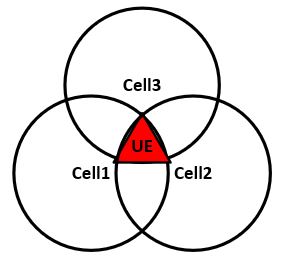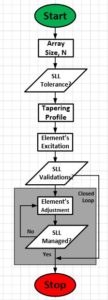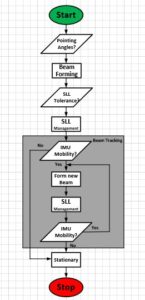- What is an Algorithm?
- SLL Management Algorithm
- Beam Tracking Algorithm
- What is Beam Splitting?
- The Art of Triangulation Location Finding
- Why DSP Algorithms are implemented via Fixed Point in FPGA?
- Antenna Tuners
- SLL Management Algorithm Flow
- Beam Tracking Algorithm Flow
- Machine Learning Algorithms
- Clutter Rejection Algorithm
What is an Algorithm?
An algorithm is a set of rules, step by step, and/or process for completing a very specific task.
In High tech industry, within the invention of any machine, automate piece of equipment, always if not many, at least one algorithm is used for expediting the execution of sequence of an event.
In particular, Wireless Communication and Radar Systems industries use many algorithms to accomplish and maintain functionality as well as performance of your wireless device, phone, laptop, microwave oven, etc.
ORTENGA subject matter experts design and develop algorithms, such as but not limited to Automatic Gain Control, AGC, of transmitter and/or receiver chains, aka transceiver, synchronization between transmitter and receiver, calibration of RFIC, RF impairment estimations and corrections, controlling beamforming of a Software Defined Antenna.
Whether you use ASIC devices from vendors or you design and develop ASIC which needs to interface with multiple devices within the HW systems environment in any Radio Applications and Standard, ORTENGA can develop appropriate algorithms to meet the requirements.
SLL Management Algorithm
Side Lobe Level, SLL, management is requirement for any beamforming and beam tracking radio communications or radar systems. gNB , LEO SATCOM, 802.11ad/ay, and radar systems rely on beamforming and beam tracking technologies as well as SLL management algorithm to comply with FCC unwanted emission requirements which are really needed for multiple access or users’ radio coexistence.
SLL management algorithm works hand in hand with beamforming and beam tracking algorithms. As the beam formed and tracks the targets, the radiation pattern is dynamically changing every fraction of second, e.g. every couple of hundred microseconds in LEO SATCOM, therefore the SLL must be managed automatically to meet FCC requirements at all times to avoid interfering with other users. This is only possible if SLL management algorithm is in place within the radio system to ensure not exceeding an upper level SLL, hence safe level for other users or misidentify the target in radar applications.
Partner with ORTENGA to design and develop SLL management algorithm for your product.
Beam Tracking Algorithm
5G and SATCOM not only rely on Beamforming but also on Beam Tracking algorithm.
Beam tracking is needed when transmitter, receiver, or both are mobile, and required in addition to Beam forming algorithm.
Beam tracking algorithm can be categorized into 3 different use cases, namely; gNB, GEO and LEO SATCOM applications.
- Beam tracks mobile targets, while the transmitter is stationary. For instance, gNB tracks mobile UE.
- Beam tracks stationary target, while the transmitter is mobile. For instance, mobile SATCOM UT is tracking GEO satellite.
- Beam tracks mobile targets, while the transmitter is mobile. For instance, mobile SATCOM UT is tracking LEO satellites.
All of the above algorithms can be realized for new technologies.
ORTENGA can design and develop the above algorithms depending on the applications and use cases.
What is Beam Splitting?
Beamforming, BF, is an electronic technique to form Electromagnetic waves in the desired direction either for Transmit or Reception of radio waves. BF can be designed with either Phased Array Antennas or Holographic Metamaterial Antennas.
In gNB or LEO applications, there are use cases which either multiple users or multiple satellites have to be illuminated. In those scenarios, the Phased Array Antennas or HGBF antennas can split the beam in two or even multiple directions with the expense of losing antenna array gain or increased HPBW.
Since the beam splitting occurs electronically, therefore depending on the electronics of the radio front end, this can occur in fraction of seconds and appears seamless connectivity.
In fact, gNB infrastructure currently is using this technique for 28 and 39 GHz mmW 5G technology.
The Beam Splitting technique can also be utilized in LEO SATCOM application.
Partner with ORTENGA to design and develop your BF product.
The Art of Triangulation Location Finding
Location finding of mobile UE in radio network has become ubiquitous feature with multiple use cases.
The art is to triangulate the UE as accurate as possible. The triangulation means determining the timing measurements from at least 3 reference points and calculating the distance from these points to locate the UE.
The following diagram illustrates triangulation of UE by three cellular sites.

In practice, it boils down to detecting signals from the Cellular Sites, estimating the relative timing based on the signal strength and estimation of appropriate part of the sub-frame of cellular packet format/protocol as well as digital signal processing algorithms which are based on statistical analysis.
The calculated location of the UE would be to within a “Triangle”, or uncertainty. The smaller triangle the better the signal detection and/or algorithms.
Partner with ORTENGA for location finding HW/Algorithm design and development.
Why DSP Algorithms are implemented via Fixed Point in FPGA?
Currently, typical HW simulators such as Matlab use 64-Bit representations for numbers.
1 Bit can be defined as distinguishing an in-distinguishable.
Typical DSP algorithms do not need such wide, 64-Bit, word for its variable to arrive at acceptable computation tolerances. In fact, implementing 64-Bit Algorithm could be costly in terms of power consumption, required memory, and computation time, critical algorithm metrics.
On the other hand, lack of adequate Word Length could cause convergence issue, inaccurate results, and erroneous decision makings.
Proper Algorithms are optimized for all of the above metrics.
Algorithm designer can calculate the required number of Bits, Word Length, for tolerable error in computation. This calculation is called Floating Point to Fixed Point Conversion.
There are many techniques to make the conversion and even Matlab can do that for you.
However, there is more efficient technique which will be faster to make the conversion and ORTENGA utilize that.
Partner with ORTENGA for DSP Algorithms and FPGA implementations.
Antenna Tuners
Historically antenna tuners meant any passive interface impedance matching device between the antenna and the RF front end. This terminology has carried over to UE and/or mobile devices. In addition, as the need for multiple bands antenna increased, the need for antennas that can operate at multiple bands became prime interest of ODMs. Nowadays, antenna tuning could either imply antenna impedance tuning or antenna aperture tuning. The aperture tuning mechanism is part of antenna structure and changes antenna resonance frequency, hence operating at multiple bands.
Partner with ORTENGA to design and develop Antenna Tuning Algorithms for your new product.
SLL Management Algorithm Flow
Side Lobe Level, SLL, are undesired radiation characteristic of any antenna or antenna arrays.
Many companies spent significant amount of time and resources during the prototype development phase to mitigate SLL and qualify/certify the radiation pattern by FCC. The issue which remains is two folds even after they succeed to meet FCC and regulatory requirements.
First, the SLL mitigation technique used are not optimum design performances and typically sacrifice antenna gain and power efficiency of Power Amplifier to meet regulations. This in turn translates to lower C/N and/or Eb/N0, therefore lower throughput. In other words, the transmitter suffers power efficiency as well as optimum throughput, two critical metrics for any transmitter in exchange for mitigating SLL, which should have been part of original design to begin with, hence lack of optimum design.
Spending resources to design efficient power amplifier, yet backing off from efficiency sweet spot of Power Amplifier due to undesired and uncontrolled SLL defeats the purpose of the overall system metrics; that power efficiency and throughput, both of which impact bottom lines of the network operator.
Second, the additional time which takes for trial and error is reducing the chances of being in the market during the window of opportunity.
ORTENGA SLL Management Algorithm is proactive design and embedded during the development phase to expedite TTM while producing optimum design trade-off Gain vs. SLL, hence power efficiency and throughput, below algorithm flow.

Partner with ORTENGA for design and development of radio algorithms and implementations in your new product.
Beam Tracking Algorithm Flow
Beam Tracking Algorithm is utilized when there is beamforming and mobility either at transmitter or receiver.
The following diagram illustrates top level algorithms flow interactions, namely; Beamforming, SLL management, and Beam tracking.

It is worth mentioning that although the high level flow diagram is similar yet actual flow diagram may change depending on the applications and use cases. For instance, in some use cases or applications, there is need for Target Acquisition Algorithm, before beam tracking algorithm of the target is invoked.
Partner with ORTENGA in design and development of any of the above algorithms for your new product.
Machine Learning Algorithms
There are many design problems which do not have known theoretical or analytical solutions, yet they have practical applications, therefore demand in the technical market space.
M2M communications require some level autonomous in learning and decisions making to ensure, no human interactions.
If you have any of these problems, ORTENGA has subject matter expertise to help you define the scope and then provide appropriate ML algorithm to address that.
Clutter Rejection Algorithm
Radar clutter reduces SNR therefore it reduces the detection, consequently the radar capability in identify the object of interests.
Regarding Autonomous Automotive, reducing the clutter enhances the radar in identifying and distinguishing various objects’ scatterer on and near the road.
Augment ORTENGA in your Radar design and development.